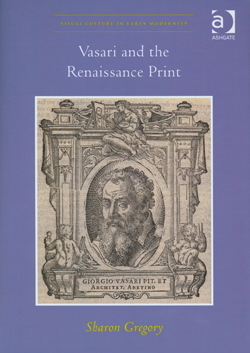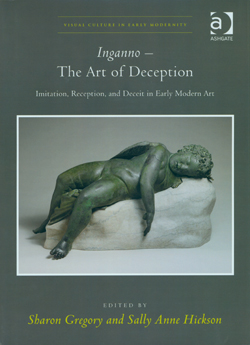
Much of my research has focused on the painter and first art historian, Giorgio Vasari. My book, Vasari and the Renaissance Print, was recently published by Ashgate. The book cover (L) is a link to Ashgate.
“Prints changed the history of art, even as that history was first being written. In this study, Sharon Gregory argues that this reality was not lost on Vasari; she shows that, contrary to common opinion, prints thoroughly pervade Vasari's history of art, just as they pervade his own career as an artist. This volume examines Giorgio Vasari's interest, as an art historian and as an artist, in engravings and woodblock prints, shedding new light not only on aspects of Vasari's career, but also on aspects of sixteenth-century artistic culture and artistic practice. It is the first book to study his interest in prints from this dual perspective.
Investigating how prints were themselves more often interpretive than strictly reproductive, Gregory challenges the long-held view that Vasari's reliance on prints led to errors in his interpretation of major monuments. She demonstrates how, like Raphael and later artists, Vasari used engravings after his designs as a form of advertisement through which he hoped to increase his fame and attract influential patrons. She also explores how contributing illustrations for books by his scholarly friends, Vasari participated in the contemporary exchange of intellectual ideas and concerns shared by Renaissance humanists and artists.”
My overarching research programme examines multifaceted relationships among artists, writers and humanists in Renaissance Italy. My investigation into the careers of Giorgio Vasari and the Florentine poligrapher Anton Francesco Doni has highlighted the need for a broader study of Tuscan artists in Venice, and the reciprocal influence of Venetian and Florentine artists and literati during the 16th century.
Tuscan artists, including Leonardo da Vinci, Michelangelo, Francesco Salviati, Vasari, and Jacopo Sansovino, came to Venice for many reasons: the diaspora from Rome after the 1527 Sack, the allure of Venice's republican government, and the draw of Venice’s literary circles and publishing industry. Their (sometimes brief) Venetian sojourns, in turn, had an impact upon their own work.

We know of some projects that these artists worked on in Venice, but facets of their activity are mysterious. The contribution of Tuscan artists to Venice’s publishing industry, in the form of designs for book illustrations, remains largely neglected. Artists often brought artworks with them; these objects need to be identified, and their lingering effects on Venetian art studied. Florentine artists mingled with Venetian artists, but also with authors, humanists, and religious reformers. These relationships had repercussions for broader intellectual and cultural debates, on subjects such as the form of the vernacular language, literary and artistic imitation, and decorum in the arts and literature.
My co-edited book, Inganno - The Art of Deception, was recently published by Ashgate. The book cover (R) is a link to Ashgate.
"The essays contained in this volume address issues surrounding the use, dissemination, and reception of copies and even deliberate forgeries within the history of art, focusing on paintings, prints and sculptures created and sold from the sixteenth century to the eighteenth century. The essays also probe contemporary sensibilities about the art of "inganno," or deception, sometimes even viewed as pleasurable deception, in the making and viewing of copies among artists and their audiences.
Through specific case studies, the contributors explore the fine line between imitations and fakes, distinctions between the practice of copying as a discipline within the workshop and the willful misrepresentation of such copies on the part of artists, agents and experts in the evolving art market. They attempt to address the notion of when a copy becomes a fake and when thoughtful repetition of a model, emulation through imitation, becomes deliberate fraud. The essays also document developing taxonomies of professionals within the growth of the "business of art" from the workshops of the Renaissance to the salons and galleries of eighteenth-century London.
As a whole, this volume opens up a new branch of art historical research concerned with the history and purpose of the copy."
Below are examples of published works:
Vasari, prints and imitation.
For the final draft (.pdf) accepted for publication, click here
© Gregory, Sharon,"Vasari, prints and imitation"; in Drawing 1400-1600: Invention and Innovation, Edited by Stuart Currie, Ashgate, 1998 (out of print)
_________________________________________________________________________
"'The outer man tends to be a guide to the inner': the woodcut portraits in Vasari's Lives as parallel texts"
For the final draft (.pdf) accepted for publication, click here
© Gregory, Sharon,"'The outer man tends to be a guide to the inner': the woodcut portraits in Vasari's Lives as parallel texts" in The Rise of the Image: Essays on the History of the Illustrated Art Book, Edited by Rodney Palmer and Thomas Frangenberg. Ashgate, 2003
(out of print)
_________________________________________________________________________
“The Unsympathetic Exemplar in Vasari’s Life of Pontormo", click here
© Sharon Gregory, “The Unsympathetic Exemplar in Vasari’s Life of Pontormo,” Renaissance Studies, Vol. 23:1 (February 2009), pp. 1-32. With thanks to Renaissance Studies, the Society for Renaissance Studies, and Blackwell Publishing. The definitive version is available at Blackwell-Synergy, Wiley OnLine Library.
_________________________________________________________________________
"Giorgio Vasari and Francesco Marcolini", click here
©Sharon Gregory, “Giorgio Vasari and Francesco Marcolini,” in ‘una insalata di più erbe’: A Festschrift for Patricia Lee Rubin, ed. Jim Harris, Scott Nethersole and Per Rumberg. London: The Courtauld Institute of Art, 2011, pp. 21-30, 181-183.
_________________________________________________________________________
